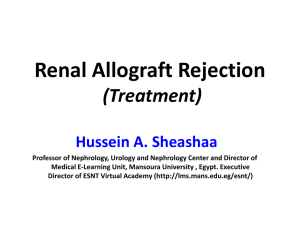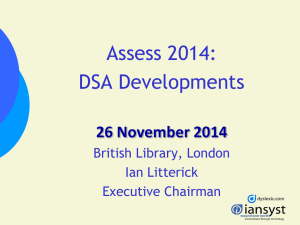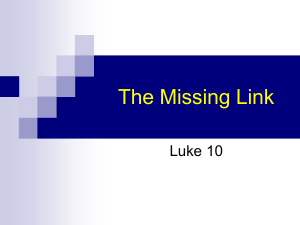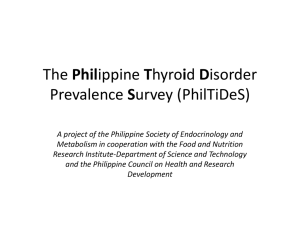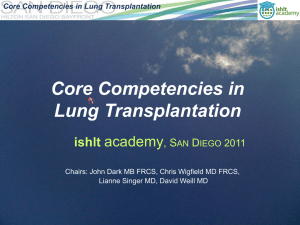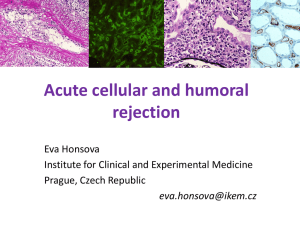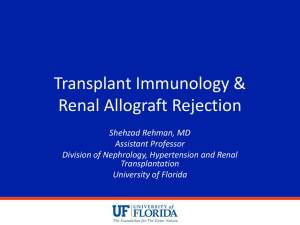Current problems in kidney transplantation: Clinical point of view
advertisement
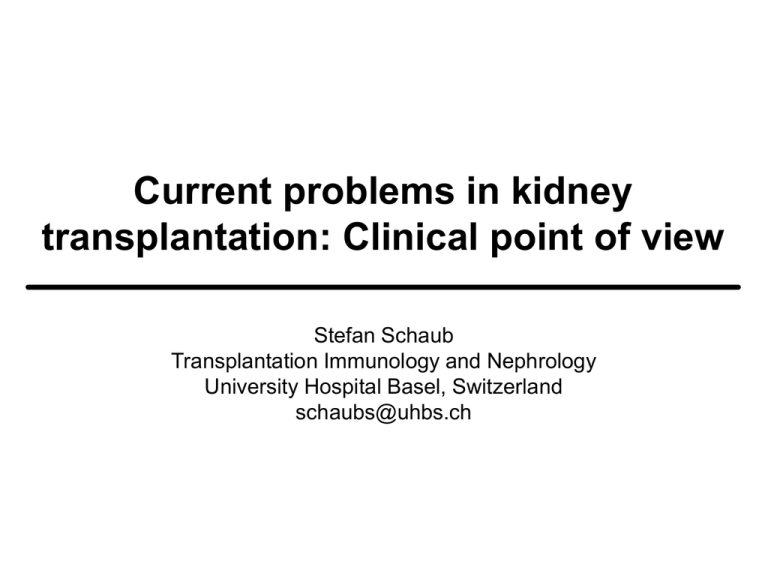
Current problems in kidney transplantation: Clinical point of view Stefan Schaub Transplantation Immunology and Nephrology University Hospital Basel, Switzerland schaubs@uhbs.ch Allograft loss Recipient death with functioning allograft Allograft failure 50% 50% Age!! Cardiovascular Infection Malignancy Why do renal allograft fail? Unknown 10% Acute rejection 12% Medical, surgical 16% „Chronic“ rejection 24% (Recurrent) GN 22% CNI-toxicity 1% IF-TA: other, specified causes 8% PyVAN 7% Adapted from El-Zoghby. AJT, 2008 How to prevent acute / chronic rejection? 1) Avoid transplantation in high risk constellations (e.g. preformed donor-specific memory) 2) Screening for early / subclinical rejection How to prevent acute / chronic rejection? 1) Avoid transplantation in high risk constellations (e.g. preformed donor-specific memory) 2) Screening for early / subclinical rejection HLA-antibodies as a surrogate for memory Pregnancy Naive T-cell Activated T-cell Memory T-cell Tn Transfusion Transplant Bn Naive B-cell IgM positiv Ta Tm PC Plasma cell IgG positiv IgG HLA-Ab Luminex Multiplex technology Color-coded beads A1 A11 bea d A2 A3 A24 A25 Flow cytometer Data B7 B8 B27 B51 B52 B62 Clinical relevance of HLA-DSA detected by Luminex Author Year N DSA+ AMR Graft survival Patel 2007 60 20 ↑ = Gupta 2008 121 16 ↓ Berg Loonen 2008 34 13 = Aubert 2009 114 11 = = Amico 2009 334 67 ↑ ↓ Wahrmann 2009 338 39 ↑ ↓ Vlad 2009 325 27 ↑ = Lefaucheur 2010 402 76 ↑ ↓ Willicombe 2011 480 45 ↑ ↓ Caro-Oleas 2012 892 50 ↑ ↓ Otten 2012 837 290 ↓ Complex biology… T-cell 1. Magnitude and durability of the humoral memory response B-cell Plasma cell Complement anti-HLA-antibodies 4. Density of HLA-molecule expression 2. Binding strength of HLA-DSA to the target epitope 3. Capacity of HLA-DSA to activate complement Donor HLA 5. Protective factors and ‚absorptive capacity‘ of endothelial cells Amico P. Curr Opin Organ Transplant 2009 Organ allocation HLA-antibodies No HLA-antibodies Try to transplant around DSA Proceed with transplant - Acceptable mismatch program - Living donor exchange program Transplantation around DSA not achievable - Adapt immunosuppression!! How to prevent acute / chronic rejection? 1) Avoid transplantation in high risk constellations (e.g. preformed donor-specific memory) 2) Screening for early / subclinical rejection Subclinical allograft pathologies „Clinical“ pathologies Serum creatinine threshold „Subclinical“ pathologies - Rejection (AMR, TCMR) Nickerson P. JASN 1998 Rush D. AJT, 2007 Loupy A. AJT, 2009 - CNI-toxicity Nankivell B. NEJM, 2003 - Polyomavirus nephropathy Schaub S. AJT, 2010 Clinical relevance of subclinical “TCMR” Interstitial fibrosis with inflammation at one year predicts decline of allograft function Park WD. JASN, 2010 Natural history of de novo DSA and AMR Hourmant. JASN 2005 Moreso. Transplant 2012 Wiebe. AJT 2012 Liefeldt. AJT 2012 Wiebe C. AJT 2012;12: 1157–1167 Screening for subclinical TCMR/AMR Surveillance biopsies In which patients? When? How often? Non-invasive rejection biomarkers to tailor surveillance allograft biopsy frequency to the individual needs of every patient. De novo DSA as a non-invasive biomarker for subclinical AMR Not useful <1 year post-transplant (low prevalence) Annually beyond the 1st year. Restricted to patients at risk? Detection of de novo DSA should be followed by a biopsy Treatment options for chronic active AMR are very limited Prevention of development of de novo DSA is important: - Screen for and treat subclinical TCMR - Do not minimize IS in patients with repeated TCMR - Reinforce drug adherence and improve DR/DQ-matching Urinary CXCL10 chemokine as a biomarker for subclinical TCMR CXCL10 CXCL10 CXCL10 CXCL10 Jackson JA, AJT 2011 Ho J, Transplantation 2011 Schaub S, AJT 2009 Hu H. Transplantation 2009 Matz M, KI 2006 Hauser IA, JASN 2005 Hu H, AJT 2004 CXCL10 Demographic data – surveillance biopsies (n=362) Acute score zero (n=206) Interstitial infiltrates only (n=37) Tubulitis t1 + any i/v/g/ptc (n=86) Tubulitis t2-3 + any i/v/g/ptc (n=21) Isolated vascular compartment inflammation (n=12) 0 0 0 0 0 1.2±0.4 0 0 0 0 1.2±0.6 1 0.1±0.3 0.2±0.4 0.2±0.5 2.0±0.7 2.2±0.4 0.2±0.5 0 0 0.3±0.5 0 0.6±0.5 0.3±0.5 0.3±0.5 eGFR 47 (39-58) 51 (45-59) 47 (37-58) 43 (31-57) 48 (36-58) 0.57 Proteinuria - Prot/creat - a1m/creat 13 (8-21) 4 (2.5-8.1) 13 (10-24) 6 (3.7-8.5) 14 (9-24) 5 (3.0-7.6) 12 (8-19) 6 (3.2-10.8) 12 (8-15) 5 (1.8-5.4) 0.40 0.21 Acute Scores -i -t -v -g - ptc P-level <0.0001 Hirt-Minkowski P. AJT 2012 Urinary CXCL10 – subclinical pathologies p=0.07 p<0.0001 p<0.0001 p=0.004 ≥24 22 20 18 16 14 CXCL10/creat 12 [ng/mmol] 10 8 6 4 2 0 p=0.01 p=0.30 Acute Banff score zero (n=206) Interstitial infiltrates only (n=37) Tubulitis t1 + any i/v/g/ptc (n=86) Tubulitis t2-3 + any i/v/g/ptc (n=21) Isolated vascular compartment inflammation (n=12) Urinary CXCL10 correlates with the extent of subclinical tubulo-interstitial inflammation Hirt-Minkowski P. AJT 2012 Urinary CXCL10 as a non-invasive biomarker Urinary CXCL10 correlated with the extent of clinical and subclinical tubulointersitital inflammation. Moderate sensitivity (61-63%) and specificity (72-80%) - Problem 1: tubulitis t1 (=borderline changes) clinical relevance of tubulitis t1? - Problem 2: Urinary CXCL10 does not reflect vascular compartment inflammation Summary Current problems in kidney transplantation To adapt the immunosuppression to the individual needs of every patient - Surveillance biopsies - Non-invasive biomarker to guide performance of surveillance biopsies To accept the facts, that… - allograft recipients are getting older… - organ donors are getting older… - the deceased donor pool will not match the demand of the ever increasing waiting list… Acknowledgement Transplant Immunology and Nephrology Transplantation and Nephrology Winnipeg, Canada Gideon Hönger Patrizia Amico Patricia Hirt-Minkowski Felix Burkhalter Michael Dickenmann Jürg Steiger Denise Bielmann Doris Lutz Claudia Petit Peter Nickerson David Rush Julie Ho Institute of Pathology Helmut Hopfer Michael Mihatsch


